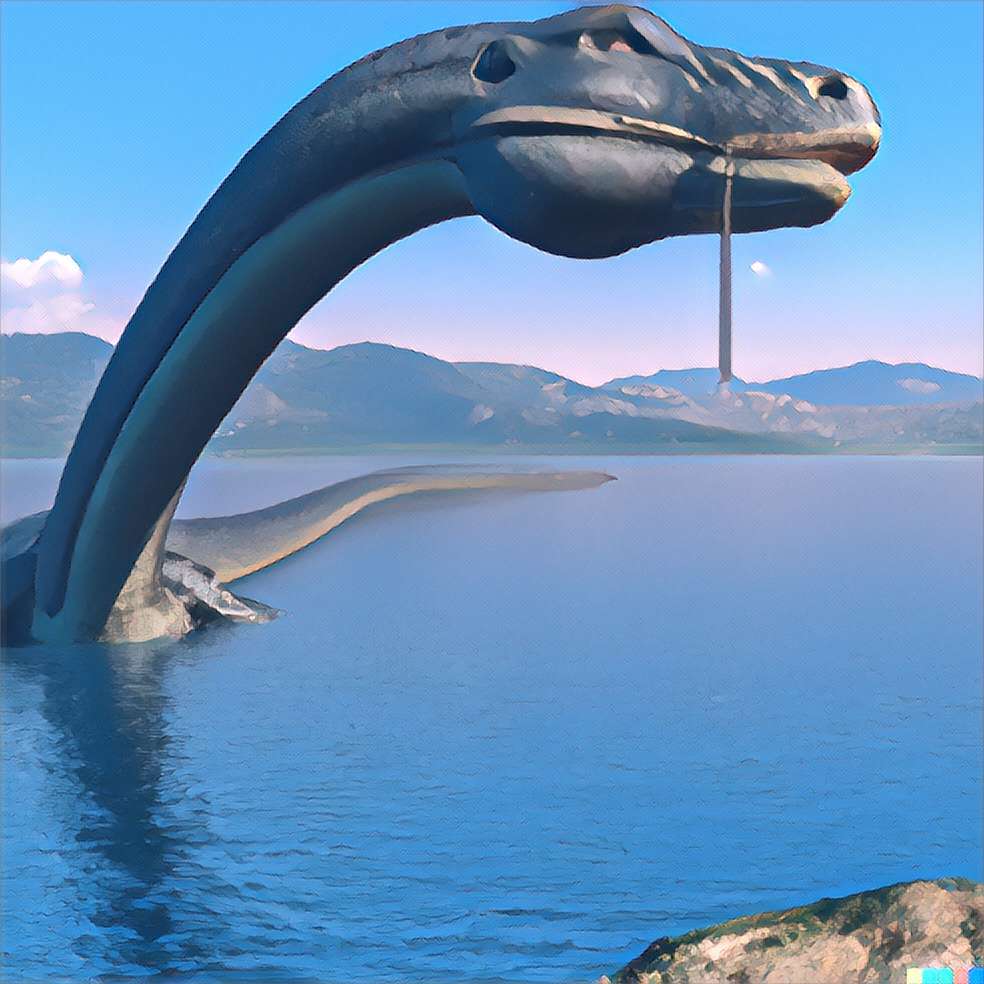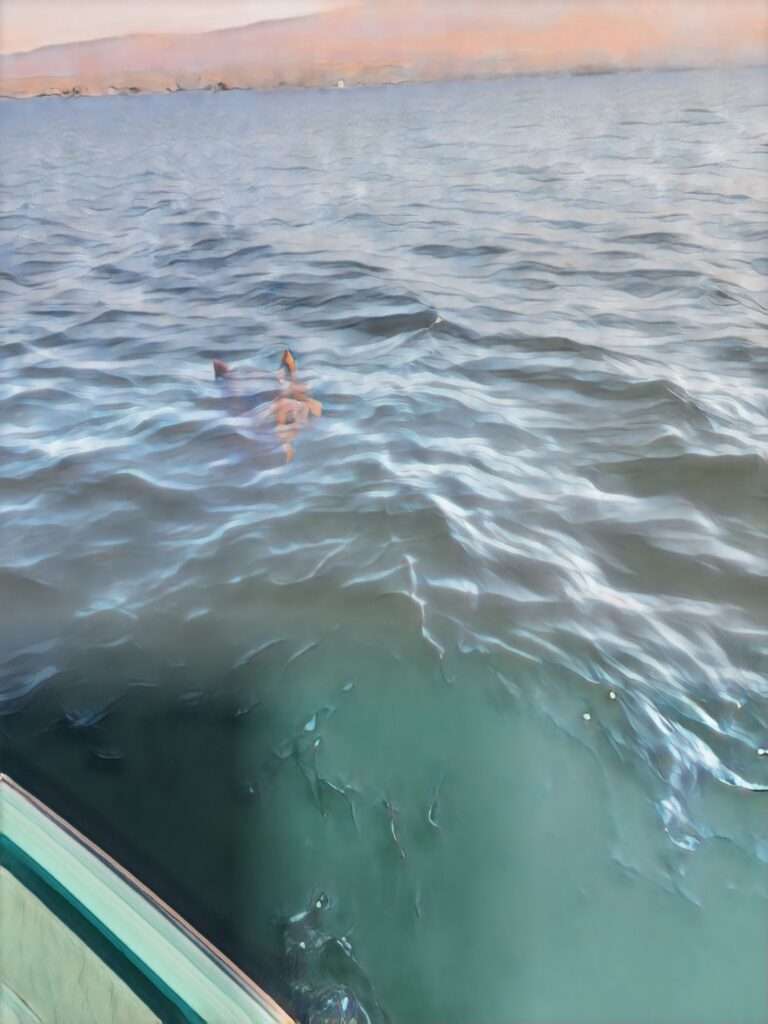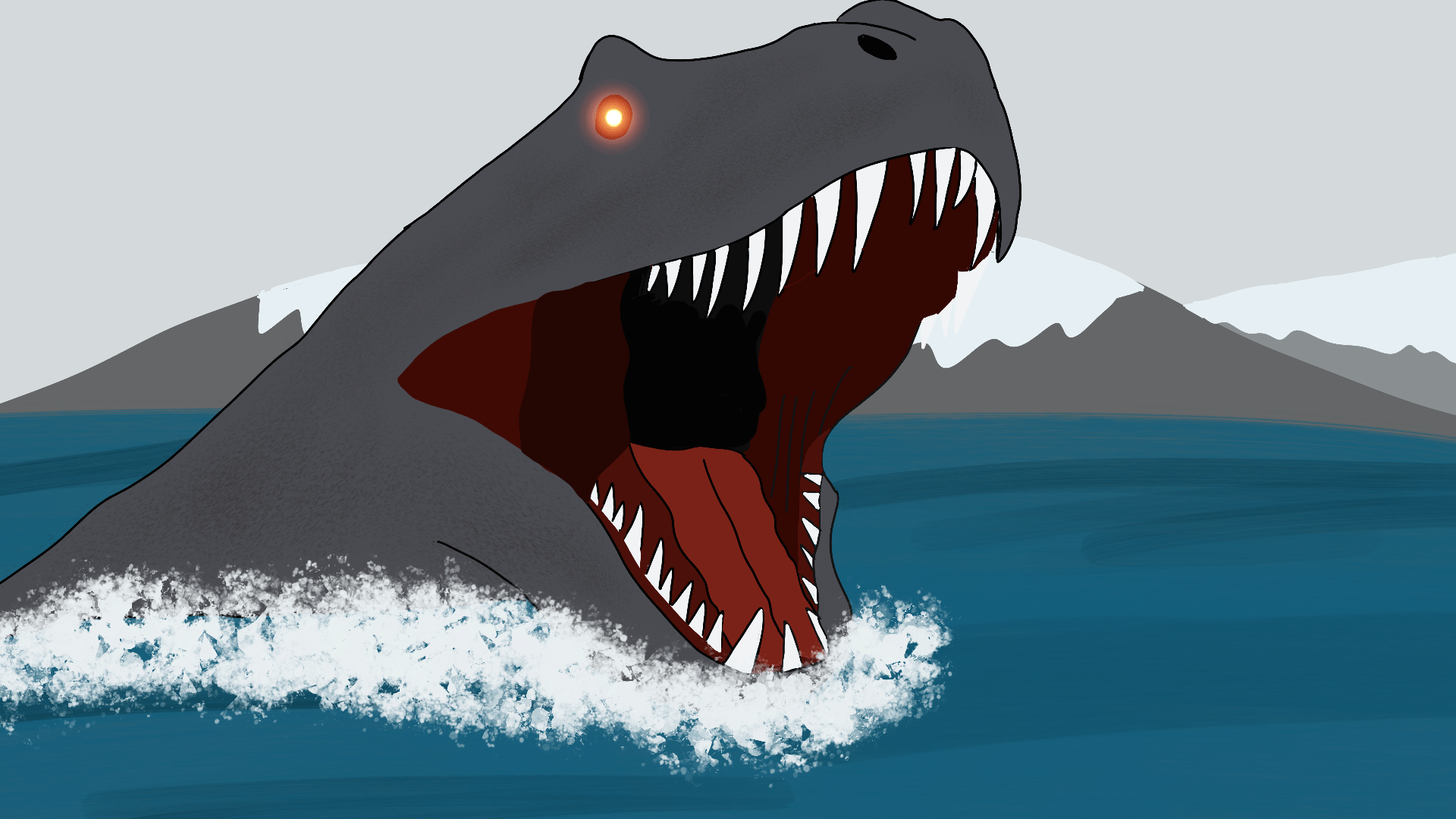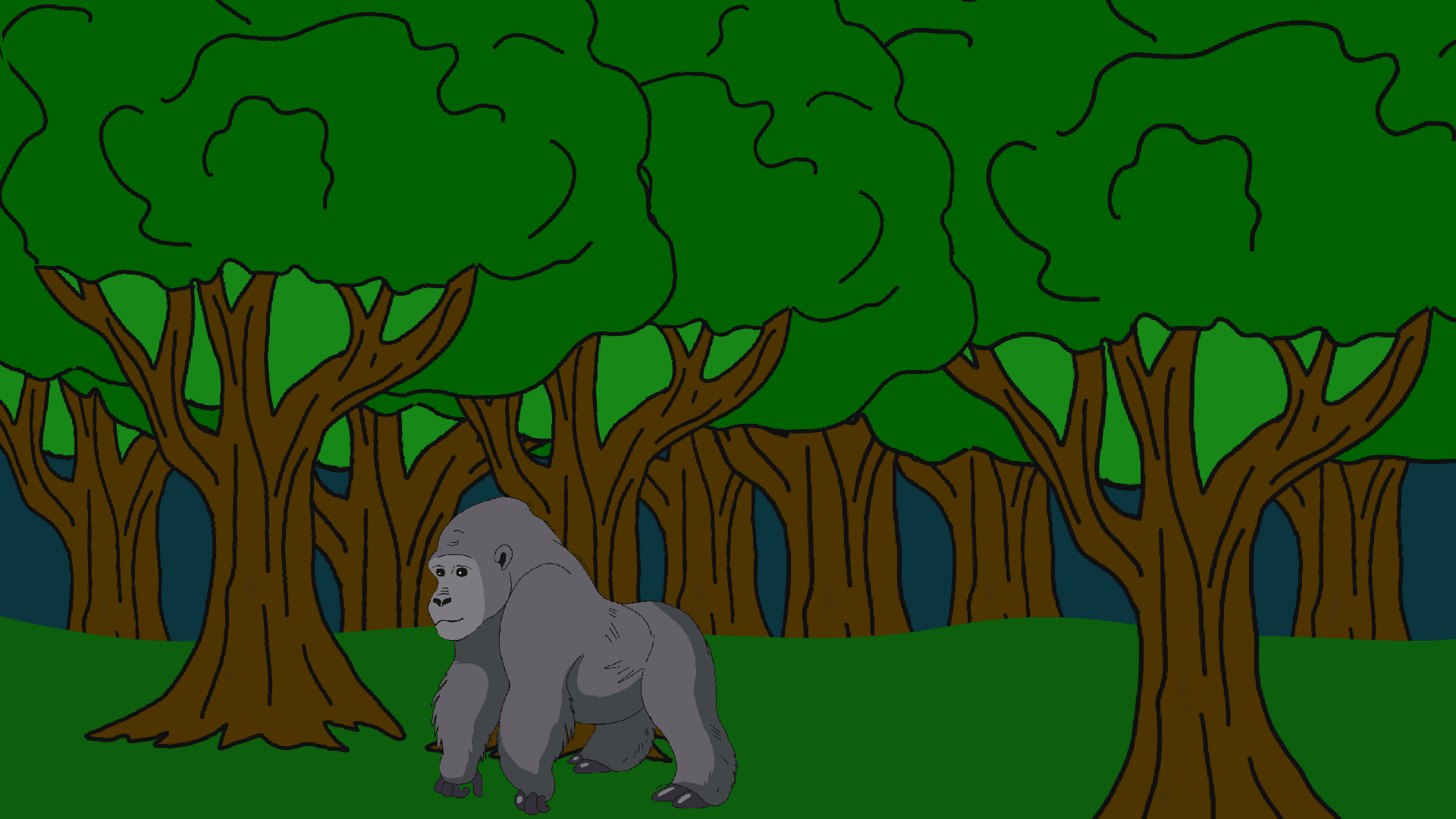
In the fall of 2022 Dale Hancher, his wife Colleen, and their friend Myrna Germaine Brown were enjoying a warm day on Okanagan Lake in British Columbia, Canada. As the day progressed, off in the distant water, Dale would spot something floating above the surface he couldn’t make out. As the three looked on in confusion, Dale told Colleen to grab the camera so they could get a photo. As they got about 10 feet away, Colleen snapped a photo, and the three continued on puzzled as to what it could be:

Dale later Recalled:
As a boater, I was just looking, is this something dangerous that needs to be marked so somebody doesn’t run into it, like a dead head or something like that,” For one thing, the two nodular things are sticking up… whatever they are, those are about three feet apart. And I’ve done some research since we took this picture and it’s not a plant. It’s not kelp because this is a lake it’s not the ocean. It’s not a sturgeon. It’s not a dead deer upside down. You can eliminate all these things, but the next question is, what is it?
As the story gained traction, many in the Okanagan Valley would suggest what Dale, Colleen and Myrna saw was the legendary lake monster, called Ogopogo.
For centuries native tribes of the area such as the Secwepemc and the Syilx, told stories of a Lake Monster, which then called Naitaka. Naitaka translates several ways including “Water God” or “Water Demon”. In their traditions and to show reverence, crossing of the lake demanded sacrificing a small animal.
Native lore tells a story of a visiting chief, named Chief Timbasket who failed to show respect. Chief Timbasket refused to sacrifice a small animal due to his denial of the demon creature. As Chief Timbasket took his family across the lake, the monster would attack the family and suck them to the bottom of the lake.
Native tribes believed the lake monster was a spirit that inhabited the caves under Rattlesnake Island.
As the years passed and more Europeans would settle in the area. One early settler was a woman, with Impeccable Credentials, and she would spot the creature and perhaps give validity to the legend.
Susan Allison was a renowned Canadian Author and pioneer. In 1860, Susan and her family immigrated to Hope, British Columbia. She would then go on to marry John Fall Allison, one of the founders of the town in Princeton in 1868. The couple moved to the Similkameen Valley, nearby the Okanagan Lake and The Allisons were able to establish goof relationships with the local tribes. Together the two had fourteen children and Susan was able to translate many stories from the tribes into English and record many of her memories of that time through several literary works.
In her writings, Susan recalls in 1872, seeing the large serpent like creature and was certain she had seen a dinosaur.
Yet other sightings occurred in the 20th century before Susan’s.
15 years earlier, Metis settler John McDougall claimed that as he had crossed the lake in his canoe, with his horses tied behind him, suddenly, the horses were violently pulled under and Mcdougall had to cut the ropes to prevent capsizing. McDougall was adamant he had crossed this exact way many times.
Lake Okanagan is about 250 miles east of Vancouver. The massive lake is about 84 miles long and between 2.5 and 3 miles (4 and 5 km) wide, with an average depth of 249 feet. The stunning beauty of the area is such in that it has attracted travelers for decades for activities such as hiking, boating and camping. Still, Within the massive lake, lies much mystery.
One such mystery lies in the formation of unexplainable waves. For local residents, there is no doubt that this strange disturbance has often been observed and even photographed on the surface. It appears that when the lake is otherwise calm and there are no boats on the water. Anyone who has seen this phenomenon knows that it is no ordinary wave. Exactly what causes this disturbance is a matter of debate. It may be the result of underwater currents, rising gases, seasonal overturn, and changing temperatures in the lake.
Still, in this mysterious lake, the biggest question lies around if a lake creature actually exists.
Although the older reports from Native Americans and Susan Allison provide support for existence of Ogopogo, the modern reports and the wide variety of reports, many with videos and photographs, provide even more evidence the monster exists.
In 1968 Arthur Folden was driving on Highway 97, when he noticed something moving in the lake. He pulled off the road and filmed what he believed was footage of the creature, showing a large wave moving across the water. Folden estimated that the Ogopogo was 300 yards offshore. Later, A computer analysis of the footage concluded it was a solid, three-dimensional object. Folden described the creature as “something large and lifelike.”
Many sightings would occur in the 1980’s with a reward being posted too.
In 1980, around 50 tourists watched an alleged Ogopogo for about 45 minutes off a beach at Kelowna. There, Larry Thal, visiting from Vancouver, shot some 8mm film capturing the beast albeit for only 10 seconds.
In 1989, John Kirk reportedly saw an animal which was 35 to 40 ft long and consisted of “five sleek jet-black humps” with a lashing tail. He believed it to be traveling at around 25 miles per hour.
Sighting continued throughout the 90’s and 2000’s with additional reports. One report of particular interest was that of Sean Viloria and his girlfriend in August 2008.
Viloria and his girlfriend, Jessica Weagers, were sitting on the lake shore of Peachland as she noticed a disturbance in the water. Sean, a photographer, snapped one photograph, but his camera died, and wasn’t able to capture more. Sean never publicized it but described it as having black hump like ridges. Eight days later south of the original sighting, Sean pulled his car over to watch at the Highway 97 widening project, and Jessica spotted another disturbance. He snapped 11 photographs of the creature as it was surfacing near a boat. One of the pictures shows a tail or neck like object surfacing the water while the others show the back and head of the creature. Sean estimated the creature being 18–20 ft long based on the boat in the background. The photos were examined by many local experts, and all concluded that it didn’t look like any known animal of the lake. Members of the show Monster Quest also studied the photographs and found no evidence of tampering.
Descriptions have varied, but certain characteristics have been repeated throughout the decades: Ogopogo is said to be green with a snakelike body about 25 meters long. Some say its head looks like a horse, while others say that it’s reptilian or goat-like.
Still, over the years different theories have been proposed as to what specifically people have been seeing.
Scientists have put forth the theory that unlike the world-renown “Loch Ness Monster”, nicknamed “Nessie”, the Lake Okanagan “resident” is probably a form of primitive whale, Basilosaurus Cetoides, which tallies almost exactly with the log like descriptions by people who claim to have seen it.
Other believers think that it could be some pre-historic dinosaur that has managed to use the shelter of the massive lake to hideout.
However, skeptics think that more recent sightings of Ogopogo were most likely something like waterfowl, otter, or beaver. Sturgeon is another popular suggestion for skeptics. They are often mistaken as lake monsters, but believers point out their existence in Lake Okanagan is unclear. In fact, there is currently an unclaimed $10,000 dollar reward for concrete evidence of sturgeon in the lake. Benjamin Radford, a skeptic on the matter, points out that waterspouts are in the lake and that activity may have led native tribes to believe that gods existed below the surface.
Perhaps the individual with the most knowledge concerning the creature and sightings is Kelowna resident Bill Steciuk. He had become to be known as the “Ogopogo Man” and runs a website, named www.ogopogoquest.com where many reported sightings are archived. Steciuk has been hoping to prove the existence of Ogopogo ever since he believes he saw the elusive legend in October of 1978. He and a group of believers have set out to prove scientifically that Ogopogo does exist.
Unlike many cryptids, there appears to be an overwhelming amount of evidence supporting that some creature does exist in the lake. There have been many eyewitness reports, often multiple witnesses together, over the decades and often these reports are accompanied with photographic and video evidence. Investigations under the water too have found suspicious activity occurring leading investigators to believe a large creature or creatures might be lurking around the waters.
As the creature has continued to gain popularity on an international scale, let’s hope that the “smoking gun” solid evidence is finally found.




I precisely desired to say thanks once more. I do not know the things I would have followed without the actual creative ideas revealed by you directly on my question. Certainly was a very terrifying dilemma in my opinion, nevertheless viewing a new specialized avenue you resolved it took me to cry for fulfillment. Extremely grateful for the support as well as expect you know what a great job you happen to be doing training some other people by way of your site. I am sure you have never met any of us.
Today, while I was at work, my sister stole my iphone and tested to see if it can survive a 25 foot drop, just so she can be a youtube sensation. My iPad is now broken and she has 83 views. I know this is totally off topic but I had to share it with someone!
I¦ve learn several good stuff here. Definitely worth bookmarking for revisiting. I surprise how much attempt you put to create any such magnificent informative website.
You have brought up a very wonderful points, appreciate it for the post.